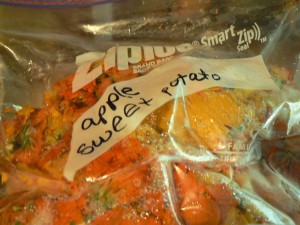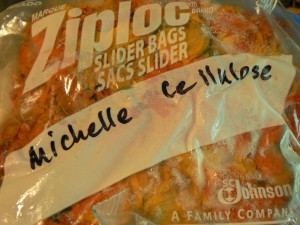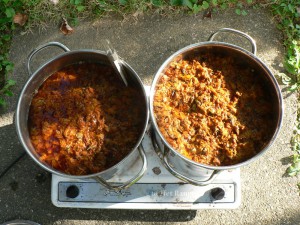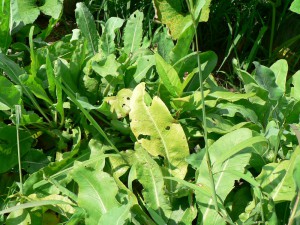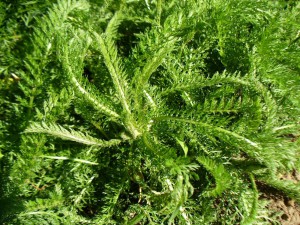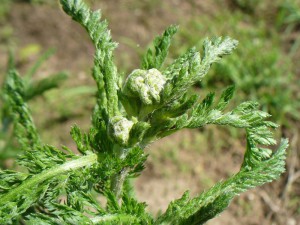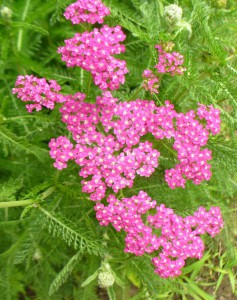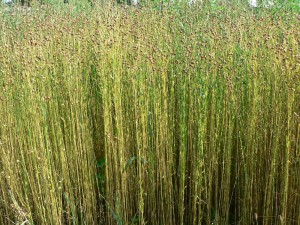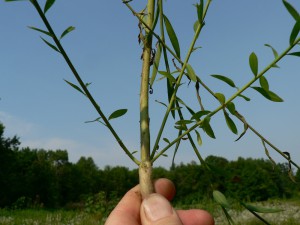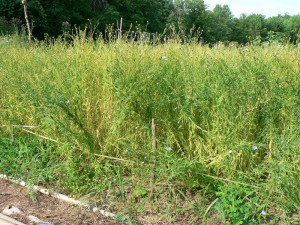Where I live in Massachusetts, our first frost is usually the first or second week of October. I feel like it has been creeping later and later in recent years, but tonight (Friday October 12th) our forecasted low is 25 degrees. I always find the first frost to be a bitter-sweet moment in the gardening year. By the time it comes, Matthew and I are usually up to our eyeballs in chilis and tomatillos, there is no room in the fridge, and we are sick of watering and weeding and squishing bugs and trying to defend beets, corn, pumpkins, or what-have-you from unknown assailants…. Continue reading “First Frost and Woad Thoughts”
To Ripple or Not to Ripple
Rippling is the process of removing seed pods from dried flax straw before retting. Traditionally, the dried bundles of flax were pulled through a comb-like tool called a ripple to remove the pods. You can see pictures of ripples here. Flax seeds are a very useful commodity, and can be pressed for oil, fed to animals or people, or saved to plant the following year. Continue reading “To Ripple or Not to Ripple”
Orange Cosmos (Cosmos sulphureus)
At this time of year there are a lot of things to harvest, including dye plants. Some things can be strung up to dry, such as marigold blossoms. Other things, such as orange cosmos flowers, I store in the freezer. When the first cosmos were ready to pick a few weeks ago, I realized that our freezer was still full of bags of cosmos I froze last summer! So on September 1st I decided I’d better make some room. Cosmos are easy to distinguish from pesto, ginger, and the other non-commercial items in our freezer, which is lucky because I had re-used zip-lock bags last summer and you can see that the labels weren’t helpful.
This is not good practice. Label your bags accurately! It is probably also not good practice to store food and non-food things in the same freezer, but we only have one freezer so that’s how it is.
I made a very strong dyebath using 5 lb. of frozen orange cosmos flowers. Since my pots are pretty small, I divided the quantity between two 2-gallon pots, and ran two baths simultaneously.
Orange cosmos are pH sensitive, and you get much redder colors if the pH is high. After straining out the flowers, I used ammonia to increase the pH. I have run out of pH test strips at the moment so I can’t tell you exactly what it was. In the initial dyebaths I added 4 Tbs. ammonia per pot (about one and a half gallons of liquid) before adding the yarn. For each subsequent exhaust bath I added 2 Tbs. ammonia. The yarn is 4 ply rug wool (Helsingin Villakehraamo from Finland, bought at the Hill Institute a few years ago), premordanted with aluminum sulfate.
Another Woad Vat
Yesterday I picked 8 and a half pounds of woad leaves. This is a lot, probably the largest quantity I’ve harvested at one time. Many of the leaves are droopy and yellow at this point in the summer. It has been hot and dry, but there is a lot of color in them, so no worries.
I had written earlier in the summer about woad’s enemies. To fend off the cabbage whites, I planted two hyssop plants, which are supposed to help. I could only find anise hyssop, which may or may not be the right type. It definitely attracts the adult butterflies, as a food source I suspect. But I’m not sure it keeps them from laying eggs on the woad, and it’s the caterpillars that eat the woad leaves, not the butterflies.
I think at this point in the summer that slugs are the main predator on the woad, but I did find quite a few cabbage white eggs. The hyssop is very pretty, though, and it smells great, and the woad is doing OK, so even if the cabbage whites are still laying eggs on it, I guess it’s all fine. Continue reading “Another Woad Vat”
Yarrow (Achillea)
I recently heard a little rhyme about the growth habits of perennials that I couldn’t believe I had never heard before: Sleep, creep, leap. This year my yarrow finally got to the “leap” stage. Yarrow, of course, grows wild all over the place and there isn’t necessarily any need to cultivate it. I have only seen it as a white-blooming wildflower (Achillea millefolium, I believe) which sometimes has a purplish or pinkish tinge. It is beautifully frothy and creamy looking. But I do cultivate it because it comes in such beautiful colors, and I have tried several varieties in the garden over the years. For some reason, the red, yellow, and orange ones have not survived, but this year my pink-flowering ones were lush and tall and bloomed in abundance.
Here is a young little yarrow plant early in the spring. It is feathery and burly at the same time. It looks a little bit like Queen Anne’s Lace when it’s young, and they often grow in similar places. But yarrow is fuzzier, almost furry, and more dense.
Here are some buds. At this stage it can look velvety and fuzzy and silvery grey.
This is what my pink-flowering type looks like in full bloom. It’s cheery, and I find it kind of humorous. The shade of pink is so bright that it entirely over-rides the feathery, lacy quality of the foliage. Continue reading “Yarrow (Achillea)”
Michelle’s Excellent Flax Adventure
On Saturday July 28th I took a long drive up to Gilmanton, NH to meet flax dresser Gina Gerhard, and to see a newly excavated historical flax retting pond. Fellow flax aficionado Faith made the long journey, too. Even though it is too late for you to see Gina in Gilmanton, it is not too late for you to enjoy Faith’s absolutely outstanding interactive program about flax at the History Workshop at Historic Deerfield. (12/24/2023 Edited to add that the link to Faith’s flax program no longer works so I deleted it.)
I am not a very ambitious driver, but despite the long haul it was well worth the trip. I met a lot of other flax enthusiasts, including fellow Master Weaver Diane Howe demonstrating her flax spinning skills and beautiful antique wheel. I came back very excited and motivated to persevere with my flax endeavors. This process is so fraught with trial and error, in my case mostly error, that it takes a lot of encouragement to persist. I am very grateful to all the folks in the flax and linen study group I’m part of for constant advice and support. Continue reading “Michelle’s Excellent Flax Adventure”
Flax Harvest at Amethyst Farm
Back on July 16th I pulled the flax at Amethyst Farm. It was the last plot I harvested, and ideally I should have pulled it about a week earlier, judging by how many stalks were totally brown and dry by the time I got around to it. We had some extremely hot weather that put those poor plants right over the edge. But you do what you can do.
Here’s the Evelin seen from the south side of the plot.
Marilyn at Amethyst Brook
Well, I thought I was done writing about the flax harvest at Amethyst Brook, our community garden plot, but I forgot to write about the Marilyn. Partly this is due to the fact that my camera started to die around this time, and I didn’t get a lot of photos. The Marilyn, as you may recall, had been the first variety to suffer from lodging. If you don’t recall, because you’re very reasonably not obsessed with all my flax triumphs and woes, I’ll recap. Continue reading “Marilyn at Amethyst Brook”
More Flax Harvesting at Amethyst Brook
In the last post I forgot to show these images of a particularly robust v.n.s. plant. The thicker stalks tend to be around the edges of the plot. This is one of the reasons, I imagine, that people usually recommend against planting in row. If you have a continuous plot, you have less edge-area relative to your total square feet. However, I can’t reach in to weed anything wider than 4 feet. If you don’t weed, in my experience, the weeds overwhelm the flax.
However, you can see several undesirable characteristics here from a fiber point of view. For one thing, it’s a very thick stalk.
Here you can see branching at the bottom of the stalk. This may reduce the length of potential bast fiber by a couple inches. Whatever extends down into the root is presumably going to detach from the rest below the branches, though again it’d be good to see this under a microscope to see what’s really going on. Continue reading “More Flax Harvesting at Amethyst Brook”
Flax Harvest at Amethyst Brook
On Friday July 13th and Sunday July 15th I harvested the flax at our community garden plot at Amethyst Brook. It took two days because there were a lot more plants in these plots, and because the v.n.s. and the Marilyn had such a problem with lodging that they were a mess to sort out and bundle up.
Here’s the v.n.s. looking toppled after it got knocked down three times or so, and I tried to encourage it back to a more upright habit. But once it went down, it was down.

